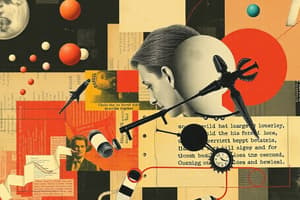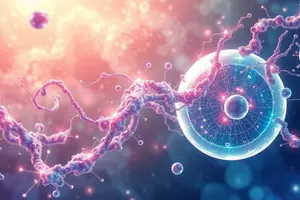Podcast
Questions and Answers
Which type of allergic reaction is characterized by the involvement of IgE antibodies and immediate symptoms?
Which type of allergic reaction is characterized by the involvement of IgE antibodies and immediate symptoms?
- Type II allergic reaction
- Type I allergic reaction (correct)
- Type III allergic reaction
- Type IV allergic reaction
What is the typical onset time for symptoms in Type III allergic reactions?
What is the typical onset time for symptoms in Type III allergic reactions?
- Days
- A few seconds
- Minutes
- Hours (correct)
Which immune system components are primarily involved in Type IV allergic reactions?
Which immune system components are primarily involved in Type IV allergic reactions?
- IgG and IgM antibodies
- Complement proteins
- T cells (correct)
- IgE antibodies
What is a common example of a Type II allergic reaction?
What is a common example of a Type II allergic reaction?
Which allergic reaction involves symptoms that typically manifest hours to days after exposure?
Which allergic reaction involves symptoms that typically manifest hours to days after exposure?
What effect does a partial agonist have compared to a full agonist?
What effect does a partial agonist have compared to a full agonist?
Which type of antagonist can be displaced by an increasing concentration of the agonist?
Which type of antagonist can be displaced by an increasing concentration of the agonist?
What characterizes the action of irreversible antagonists?
What characterizes the action of irreversible antagonists?
What type of drug mechanisms involve binding to a different receptor to counteract another drug?
What type of drug mechanisms involve binding to a different receptor to counteract another drug?
Which signal transduction system involves the activation of G proteins?
Which signal transduction system involves the activation of G proteins?
Which class of drugs acts by directly inhibiting a specific plasma membrane enzyme?
Which class of drugs acts by directly inhibiting a specific plasma membrane enzyme?
Which type of receptor allows ions to flow directly through the membrane upon drug binding?
Which type of receptor allows ions to flow directly through the membrane upon drug binding?
What is the primary outcome of using choline esterase inhibitors such as Neostigmine?
What is the primary outcome of using choline esterase inhibitors such as Neostigmine?
What characterizes a drug with a high therapeutic index?
What characterizes a drug with a high therapeutic index?
Which of the following is true about Type B adverse drug reactions?
Which of the following is true about Type B adverse drug reactions?
Which dosage measure indicates the amount needed to kill 50% of test subjects?
Which dosage measure indicates the amount needed to kill 50% of test subjects?
In the context of drug safety, what does a therapeutic window represent?
In the context of drug safety, what does a therapeutic window represent?
How can a drug's potency be defined?
How can a drug's potency be defined?
What aspect distinguishes Type C adverse drug reactions from Type A?
What aspect distinguishes Type C adverse drug reactions from Type A?
Which of the following examples illustrates a Type D adverse drug reaction?
Which of the following examples illustrates a Type D adverse drug reaction?
What does a drug's ED50 specifically indicate?
What does a drug's ED50 specifically indicate?
Which of the following is a characteristic of drugs with a small therapeutic index?
Which of the following is a characteristic of drugs with a small therapeutic index?
Which statement is accurate regarding the LD50 and its implications?
Which statement is accurate regarding the LD50 and its implications?
Flashcards
Efficacy
Efficacy
The ability of a drug-receptor complex to produce a response.
Maximal Efficacy
Maximal Efficacy
The greatest possible response a drug can produce.
Potency
Potency
The amount of drug needed to produce a specific effect.
ED50
ED50
Signup and view all the flashcards
LD50
LD50
Signup and view all the flashcards
Therapeutic Index (TI)
Therapeutic Index (TI)
Signup and view all the flashcards
Therapeutic Window
Therapeutic Window
Signup and view all the flashcards
Adverse drug reaction
Adverse drug reaction
Signup and view all the flashcards
Type A Adverse Drug Reaction
Type A Adverse Drug Reaction
Signup and view all the flashcards
Type B Adverse Drug Reaction
Type B Adverse Drug Reaction
Signup and view all the flashcards
Receptor-mediated mechanism
Receptor-mediated mechanism
Signup and view all the flashcards
Agonist
Agonist
Signup and view all the flashcards
Antagonist
Antagonist
Signup and view all the flashcards
Full Agonist
Full Agonist
Signup and view all the flashcards
Partial Agonist
Partial Agonist
Signup and view all the flashcards
Inverse Agonist
Inverse Agonist
Signup and view all the flashcards
Pharmacological antagonist
Pharmacological antagonist
Signup and view all the flashcards
Competitive antagonist
Competitive antagonist
Signup and view all the flashcards
Irreversible antagonist
Irreversible antagonist
Signup and view all the flashcards
Physiologic antagonist
Physiologic antagonist
Signup and view all the flashcards
Chemical antagonist
Chemical antagonist
Signup and view all the flashcards
Ligand-gated ion channel
Ligand-gated ion channel
Signup and view all the flashcards
G-protein coupled receptor
G-protein coupled receptor
Signup and view all the flashcards
Catalytic receptor
Catalytic receptor
Signup and view all the flashcards
Intracellular receptor
Intracellular receptor
Signup and view all the flashcards
Non-receptor mediated mechanism
Non-receptor mediated mechanism
Signup and view all the flashcards
Minoxidil reduced response
Minoxidil reduced response
Signup and view all the flashcards
Type I allergic reaction
Type I allergic reaction
Signup and view all the flashcards
Type II allergic reaction
Type II allergic reaction
Signup and view all the flashcards
Type III allergic reaction
Type III allergic reaction
Signup and view all the flashcards
Type IV allergic reaction
Type IV allergic reaction
Signup and view all the flashcards
Immune system involved (Type I)
Immune system involved (Type I)
Signup and view all the flashcards
Immune system involved (Type II)
Immune system involved (Type II)
Signup and view all the flashcards
Immune system involved (Type III)
Immune system involved (Type III)
Signup and view all the flashcards
Immune system involved (Type IV)
Immune system involved (Type IV)
Signup and view all the flashcards
Onset (Type I)
Onset (Type I)
Signup and view all the flashcards
Onset (Type II)
Onset (Type II)
Signup and view all the flashcards
Onset (Type III)
Onset (Type III)
Signup and view all the flashcards
Onset (Type IV)
Onset (Type IV)
Signup and view all the flashcards
Study Notes
Pharmacodynamics
- Pharmacodynamics studies how drugs interact with the body to produce their effects.
- Drugs act through either receptor or non-receptor mechanisms.
Receptor-mediated Mechanism
- Receptors are specific cellular structures that interact with drugs to cause a pharmacological effect.
- Drugs acting on receptors can be agonists or antagonists.
- Agonists: bind to the receptor, have affinity, and produce an effect (efficacy).
- Antagonists: bind to the receptor, block the effect of agonists, and do not produce their own effect.
Types of Agonists
- Full agonists: produce maximal efficacy.
- Partial agonists: produce less than maximal efficacy and block the effects of full agonists.
- Inverse agonists: bind to the receptor to decrease the constitutive activity (negative efficacy).
Types of Antagonists
- Pharmacological antagonists: bind to the receptor without activating it, preventing agonist activation.
- Competitive: bind reversibly; can be displaced by increasing agonist concentration. Duration depends on relative concentration of agonist and antagonist.
- Irreversible: bind irreversibly; cannot be displaced by increasing agonist concentration. Duration depends on the rate of new receptor synthesis.
- Physiological antagonists: bind to different receptors, causing opposing effects.
- Chemical antagonists: bind to the agonist drug itself.
Signal Transduction Systems
- Ligand-gated ion channel receptor: drug binding to the ion channel receptor causes ion flux.
- G-protein-coupled receptor: agonist binding activates a G protein which produces a response.
- Catalytic receptor (enzyme-linked receptor): e.g., insulin receptor; binding to the extracellular component stimulates the intracellular component and tyrosine kinase enzymes.
- Intracellular receptor: e.g., corticosteroids; the drug crosses the cell membrane and binds to a cytoplasmic receptor.
Non-receptor Mediated Mechanism
- Drugs act directly on enzymes (e.g., choline esterase inhibitors).
- Drugs act on plasma membranes (e.g., digoxin inhibiting Na+-K+ ATPase).
- Drugs act through physical means (e.g., lubricants).
- Drugs act through chemical mechanisms (e.g., antacids neutralizing HCl).
Dose-response Relationship
- Efficacy: the ability of the drug-receptor complex to produce a response.
- Maximal efficacy: the maximum response a drug can produce.
- Potency: the amount of drug needed to produce a specific effect.
- ED50: the dose that cures 50% of cases.
- LD50: the dose that kills 50% of animals (measures toxicity).
Therapeutic Index
- The ratio between LD50 and ED50.
- A larger therapeutic index indicates greater safety—the drug is less toxic.
- Drugs with a narrow therapeutic index need careful dosing.
Therapeutic Window
- The safe dosage range between the minimum effective therapeutic dose and the minimum toxic dose.
- Used to determine acceptable plasma levels for drug regimens.
Adverse Drug Reactions
- Classified into types based on their characteristics.
- Type A are dose related, associated with the pharmacological action, predictable, and often low mortality.
- Type B reactions are non-dose related, not associated with pharmacology, unpredictable, and often have high mortality.
- Type C are chronic effects, dose-related, and time-related.
- Type D are delayed reactions, time-related.
- Type E occur after the drug is discontinued, and are called withdrawal effects.
Drug Allergy
- Classifies drug allergies based on immune response types. The three types of immune-mediated drug allergy are Type I, Type II, and Type III. There is no Type IV drug allergy.
Studying That Suits You
Use AI to generate personalized quizzes and flashcards to suit your learning preferences.




